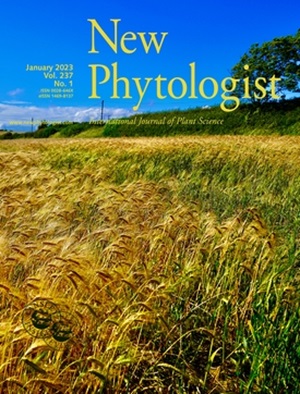The determination of leaf size on the basis of developmental traits
IF 8.3
1区 生物学
Q1 PLANT SCIENCES
引用次数: 0
Abstract
- Mature leaf area (LA) is a showcase of diversity – varying enormously within and across species, and associated with the productivity and distribution of plants and ecosystems. Yet, it remains unclear how developmental processes determine variation in LA.
- We introduce a mathematical framework pinpointing the origin of variation in LA by quantifying six epidermal ‘developmental traits’: initial mean cell size and number (approximating values within the leaf primordium), and the maximum relative rates and durations of cell proliferation and expansion until leaf maturity. We analyzed a novel database of developmental trajectories of LA and epidermal anatomy, representing 12 eudicotyledonous species and 52 Arabidopsis experiments.
- Within and across species, mean primordium cell number and maximum relative cell proliferation rate were the strongest developmental determinants of LA. Trade-offs between developmental traits, consistent with evolutionary and metabolic scaling theory, strongly constrain LA variation. These include trade-offs between primordium cell number vs cell proliferation, primordium mean cell size vs cell expansion, and the durations vs maximum relative rates of cell proliferation and expansion. Mutant and wild-type comparisons showed these trade-offs have a genetic basis in Arabidopsis.
- Analyses of developmental traits underlying LA and its diversification highlight mechanisms for leaf evolution, and opportunities for breeding trait shifts.
求助全文
约1分钟内获得全文
求助全文
来源期刊

New Phytologist
生物-植物科学
自引率
5.30%
发文量
728
期刊介绍:
New Phytologist is an international electronic journal published 24 times a year. It is owned by the New Phytologist Foundation, a non-profit-making charitable organization dedicated to promoting plant science. The journal publishes excellent, novel, rigorous, and timely research and scholarship in plant science and its applications. The articles cover topics in five sections: Physiology & Development, Environment, Interaction, Evolution, and Transformative Plant Biotechnology. These sections encompass intracellular processes, global environmental change, and encourage cross-disciplinary approaches. The journal recognizes the use of techniques from molecular and cell biology, functional genomics, modeling, and system-based approaches in plant science. Abstracting and Indexing Information for New Phytologist includes Academic Search, AgBiotech News & Information, Agroforestry Abstracts, Biochemistry & Biophysics Citation Index, Botanical Pesticides, CAB Abstracts®, Environment Index, Global Health, and Plant Breeding Abstracts, and others.
 求助内容:
求助内容: 应助结果提醒方式:
应助结果提醒方式:


